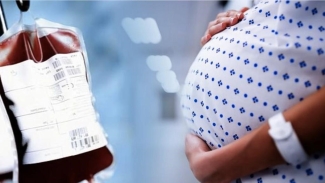Iron deficiency in pregnancy – a matter of public health

Red blood cells are like delivery trucks. They deliver oxygen to the vital organs in our body. Iron is the flatbed of the truck which holds the oxygen in place. Iron is a key ingredient to build red blood cells and when you don’t have enough iron, your body doesn’t make enough red blood cells. This is called anemia. We get iron from the foods we eat such as meat, leafy green vegetables and legumes – all rich in iron. Our body loses iron when we lose blood, so women are at the highest risk for low iron since blood is lost monthly during childbearing years.

Imagine a woman’s iron stores as a bank account, and because of menstrual periods leading up to pregnancy most women enter pregnancy with low balances. Also, pregnancy itself is like taking out substantial iron withdrawals every day because it takes over one gram of iron to make a baby – that’s equivalent to 177 steaks! So, if the withdrawals are larger than the deposits, she empties her account and anemia develops, which puts the mother at risk for severe fatigue, difficulty concentrating, shortness of breath and postpartum depression. Also, without enough iron, a woman’s red blood cell count can drop dangerously low, prompting a blood transfusion. For babies, iron deficiency anemia can be even worse as it leads to low birth weight, preterm delivery, delayed development, poor future academic performance and even early death. Luckily, treating iron deficiency in pregnancy is straightforward: it involves making regular small bank deposits with oral iron supplements or getting a big paycheck with intravenous iron.
Why is a blood transfusion particularly worrisome in women of childbearing age? It is because being exposed to someone else’s red blood cells can trigger a woman to make antibodies. These antibodies can then complicate a future pregnancy as they target and destroy the fetus’s red blood cells, causing potentially life-threatening anemia. So, iron deficiency in pregnancy is a big deal – it carries important risks to mother and baby for this and future pregnancies.
We wanted to know how commonly women are being transfused during pregnancy at our hospital and if they are being transfused for unrecognized, untreated iron deficiency anemia. In other words, we wanted to know how often women and their babies are being put unnecessarily at risk. To answer this question, we looked at all pregnant women transfused in the last 5 years and reviewed their medical records to see if they were tested and treated for iron deficiency. We also compared each woman’s results to those of an age-matched woman who was not transfused, because we wanted to know what differentiates the transfused women from the non-transfused women.
We found that transfused women were over 3 times more likely than non-transfused women to have uncorrected iron deficiency anemia. This highlights how important iron is for building red blood cells and avoiding blood transfusion. We also found that twin or triplet pregnancies and emergency C-sections both increase the risk of requiring a blood transfusion.
For example, consider Shelly, a 31-year-old woman with low iron stores before pregnancy who is now pregnant with twins. Her iron and red blood cell levels have been dropping throughout her pregnancy, and on the day of delivery both are very low. She has a normal vaginal delivery and loses a small amount of blood. The next morning, her red blood cell count is extremely low, and she receives a blood transfusion. Shelly started pregnancy with a low bank account balance. The daily withdrawals from her bank account were doubled (twins), and her deposits were insufficient to compensate. Iron deficiency anemia was a predictable and preventable outcome that should have been recognized early and treated with iron. Our goal is to target patients like Shelly.

Our research shows that 1 in 3 pregnant women did not have their iron levels checked. In women who were identified as being deficient, less than half were treated with iron. This highlights an important gap in prenatal care and we believe that this problem is not unique to our hospital. All women should have iron stores checked and their iron supplementation tightly managed throughout pregnancy. Unrecognized, unprioritized iron deficiency in pregnancy is a universal public health problem.
Understanding why women are being transfused in pregnancy helps us identify areas for improvement. Obstetricians are on the front lines and feeding this information back to them is key to addressing the under-recognition and under-treatment of iron deficiency in pregnant women. The next step is to empower obstetricians to identify at-risk women early and prevent iron deficiency anemia throughout pregnancy. If we can prevent empty bank accounts, we can minimize blood transfusions to a vulnerable patient population and prevent the development of antibodies that can complicate future pregnancies.
Dr. Heather VanderMeulen is a third year Internal Medicine resident and soon-to-be Hematology fellow at the University of Toronto. Under the mentorship of Dr. Jeannie Callum and Dr. Michelle Sholzberg, she has developed a passion for women’s health and hematology. Her goal is to improve the quality of care provided to women of childbearing age with hematologic disorders.
The 2018 Canadian Blood Services Lay Science Writing Competition was organized by the Canadian Blood Services’ Centre for Innovation with welcome support from Science Borealis and the Centre for Blood Research at the University of British Columbia.
Canadian Blood Services – Driving world-class innovation
Through discovery, development and applied research, Canadian Blood Services drives world-class innovation in blood transfusion, cellular therapy and transplantation—bringing clarity and insight to an increasingly complex healthcare future. Our dedicated research team and extended network of partners engage in exploratory and applied research to create new knowledge, inform and enhance best practices, contribute to the development of new services and technologies, and build capacity through training and collaboration. Find out more about our research impact.
The opinions reflected in this post are those of the author and do not necessarily reflect the opinions of Canadian Blood Services nor do they reflect the views of Health Canada or any other funding agency.